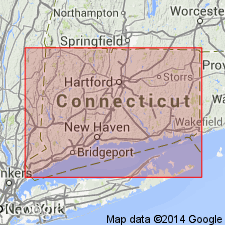
- Usage in publication:
-
- Collins Hill formation
- Modifications:
-
- Named
- Dominant lithology:
-
- Schist
- Gneiss
- Amphibolite
- Quartzite
- AAPG geologic province:
-
- New England province
Summary:
Named for Collins Hill in Portland, Middlesex Co., central CT. Formerly included in Bolton schist by other workers. Consists of rusty-weathering, graphitic, garnetiferous two-mica schist, commonly containing sillimanite and (or) kyanite. Commonly has basal conglomerate gneiss associated with overlying well-banded unit consisting of fine-grained quartzite with manganiferous garnet and cummingtonite and of laminated amphibolite with relatively large garnets locally. Persistent amphibolite and calc-silicate layers in lower part. Interbedded calc-silicate and fine-grained biotite-muscovite gneiss abundant to west in upper part. Unconformably overlain by Bolton group northward from Great Hill. Rests unconformably on Middletown formation and on granitic rocks (Glastonbury and Maromas gneisses), which have discordant, possibly intrusive, contacts with Middletown but fail to transgress into the Collins Hill along many miles of mutual contact. Age is Middle Ordovician(?)
Source: GNU records (USGS DDS-6; Reston GNULEX).
For more information, please contact Nancy Stamm, Geologic Names Committee Secretary.
Asterisk (*) indicates published by U.S. Geological Survey authors.
"No current usage" (†) implies that a name has been abandoned or has fallen into disuse. Former usage and, if known, replacement name given in parentheses ( ).
Slash (/) indicates name conflicts with nomenclatural guidelines (CSN, 1933; ACSN, 1961, 1970; NACSN, 1983, 2005, 2021). May be explained within brackets ([ ]).

